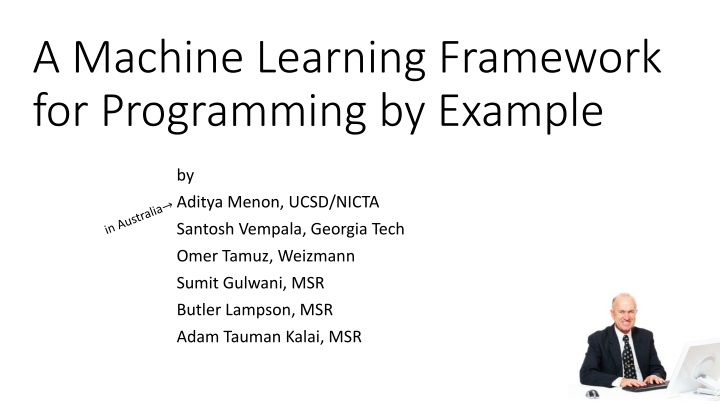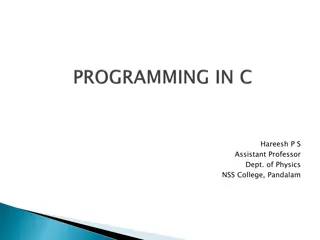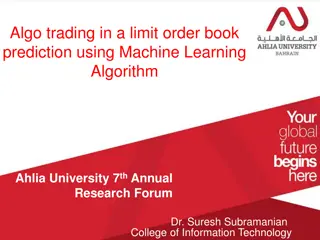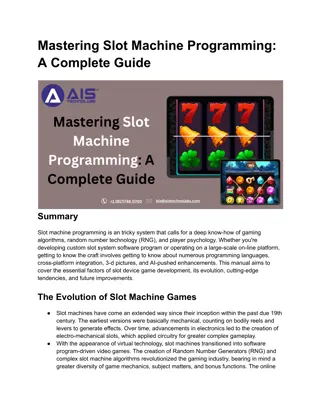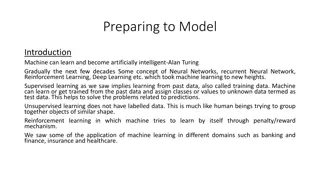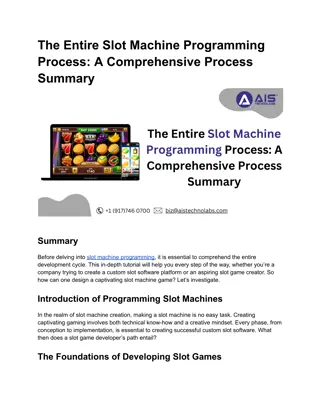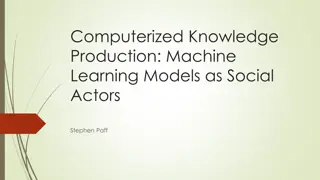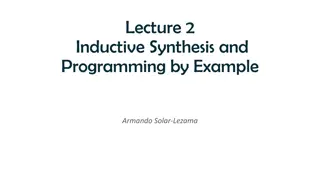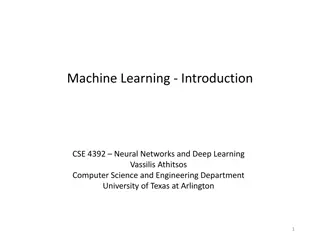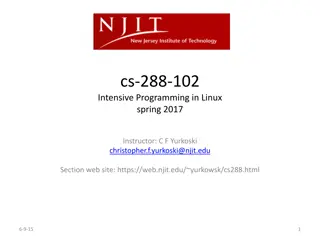Machine Learning Framework for Programming by Example
A comprehensive exploration of a machine learning framework for programming by example, featuring insights from Aditya Menon, Santosh Vempala, Omer Tamuz, Sumit Gulwani, Butler Lampson, and Adam Tauman Kalai. The framework leverages sequential transformations and steps defined by example input-output pairs to facilitate programming tasks.
Download Presentation

Please find below an Image/Link to download the presentation.
The content on the website is provided AS IS for your information and personal use only. It may not be sold, licensed, or shared on other websites without obtaining consent from the author.If you encounter any issues during the download, it is possible that the publisher has removed the file from their server.
You are allowed to download the files provided on this website for personal or commercial use, subject to the condition that they are used lawfully. All files are the property of their respective owners.
The content on the website is provided AS IS for your information and personal use only. It may not be sold, licensed, or shared on other websites without obtaining consent from the author.
E N D
Presentation Transcript
A Machine Learning Framework for Programming by Example by Aditya Menon, UCSD/NICTA Santosh Vempala, Georgia Tech Omer Tamuz, Weizmann Sumit Gulwani, MSR Butler Lampson, MSR Adam Tauman Kalai, MSR
Lawrence Carin (5) John D. Lafferty (4) Michael I. Jordan (4) Zoubin Ghahramani (4) Huan Xu (3) Ivor W. Tsang (3) Ambuj Tewari (3) Csaba Szepesv ri (3) Masashi Sugiyama (3) Nathan Srebro (3) Bernhard Sch lkopf (3) Mark D. Reid (3) Shie Mannor (3) Rong Jin (3) Ali Jalali (3) Hal Daum III (3) Steven C. H. Hoi (3) Geoffrey E. Hinton (3) Arthur Gretton (3) David B. Dunson (3) David M. Blei (3) Yoshua Bengio (3) Peilin Zhao (2) Yaoliang Yu (2) Tianbao Yang (2) Zhixiang Eddie Xu (2) Min Xu (2) Eric P. Xing (2) Jialei Wang (2) Pascal Vincent (2) The computer learns? from a few examples!
Prior work EBE [Nix85] Tourmaline [Mye93] TELS [WM93] Eager [Cyp93] Cima [Mau94] DEED [Fuj98] SmartEDIT [LWDW01] LAPIS [Miller02] FlashFill [Gulwani2011] [Liang-Jordan-Klein10] Sidestep the NP-hard search problem
Sequential Transformations by Example Programming System Sequential Transformations by Example Programming System
STEPS: Each step defined by example inputoutput Dong Yu, Frank Seide, Gang Li: Conversationa Nathan Parrish, Maya R. Gupta: Dimensionalit Dong Yu, Frank Seide, Gang Li Nathan Parrish, Maya R. Gupta (Step 1)
STEPS: Each step defined by example inputoutput Dong Yu, Frank Seide, Gang Li: Conversationa Nathan Parrish, Maya R. Gupta: Dimensionalit Dong Yu, Frank Seide, Gang Li Nathan Parrish, Maya R. Gupta Dong Yu Frank Seide Gang Li Nathan Parrish Maya R. Gupta (Step 2) (Step 1) x.Replace(/:.*$/gm,"")
: Each step defined by example inputoutput Dong Yu, Frank Seide, Gang Li Nathan Parrish, Maya R. Gupta Dong Yu Frank Seide Gang Li Nathan Parrish Maya R. Gupta (Step 1) (Step 2) (/:.*$/gm,"") x.Replace(/, /gm,"\n")
Count or append (1)? . Dong Yu Frank Seide Gang Li Nathan Parrish Maya R. Gupta Dong Yu (1) Frank Seide (1) Gang Li (1) Nathan Parrish (1) Maya R. Gupta (1) (Step 2) (Step 3) x.Replace(/, /gm,"\n")
Mock example adam adam john nina nina adam adam (3) john (1) nina (2) adam (3) nina (2) john (1) Dong Yu Frank Seide Gang Li Nathan Parrish Maya R. Gupta (Step 3) (Step 4) (Step 2) Join("\n", ListCat(Dedup(Split(?, "\n")), " (", Dedup(Count(Split(?, "\n"), Split(?, "\n"))), ")")) x.Replace(/, /gm,"\n")
Learning to Search for Programming by example Given strings ?,? ?, find good ?:? ? such that ? ? = ? (Dynamic programming& genetic algorithms won t work) ? ? P . .12 .06 .01 .01 CFG ? ? ? Join(?????, ?????) ? Peaches ? Bananas ... ????? Sort(?????, ????) ????? Reverse(?????) ????? Split(?,?????) ... ????? \n ????? ????? ? ... Join Peaches Bananas Pears Apples Apples Pears Bananas Peaches Reverse \n Split .20 .10 .22 ? \n .12 .08 .04
Learning to Search for Programming by example Given strings ?,? ?, find good ?:? ? such that ? ? = ? Enumerate PCFG programs in order of likelihood. ? ? P . .12 .06 .01 .01 CFG ? ? ? Join(?????, ?????) ? Peaches ? Bananas ... ????? Sort(?????, ????) ????? Reverse(?????) ????? Split(?,?????) ... ????? \n ????? ????? ? ... Join Peaches Bananas Pears Apples Apples Pears Bananas Peaches Reverse \n Split .20 .10 .22 ? \n .12 .08 .04 Trained on corpus of tasks from help forums
The abstract MLE problem: Given dist. ? over (?,?,data,?), find argmax Pr ??|?,?,data ?
The wrong MLE problem: Given ?,? ?, dist. ? over ?:? ?, find argmax ?:? ? =?Pr ?? ? Which program is more likely under ? Remove from : to end of line Truncate each line to 29 characters Dong Yu, Frank Seide, Gang Li: Conversationa Nathan Parrish, Maya R. Gupta: Dimensionalit Dong Yu, Frank Seide, Gang Li Nathan Parrish, Maya R. Gupta
The wrong MLE problem: Given ?,? ?, dist. ? over ?:? ?, find argmax ?:? ? =?Pr ?? ? Which program is more likely under ? Remove from : to end of line Truncate each line to 29 characters /a-z/g 24.2 Tr8 :-) 100% /^$/ 18.5 SP :( 0% /a-z/g 24.2 Tr8 /^$/ 18.5 SP
The abstract MLE problem: Given dist. ?? over (?,?,data,?), find argmax Pr ???|?,?,data ? Estimating system parameters ?: Given training corpus ??,??,data(?),?? Choose ? to minimize: ?logPr ? ?=1 ????|??,??,data(?)+ ? ? using convex optimization [Vempala]. 2
Experimental results *Everything is in Javascript Baseline = equal weights (MDL)
Conclusions Programming by Example involves hard search problem Search space generated by clues (features->CFG rules) Learn weights on heuristic clues Future work Learned shared structure (like [Liang-Jordan-Klein10]) Generate more clues on-the-fly
